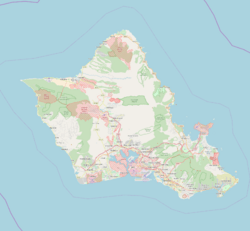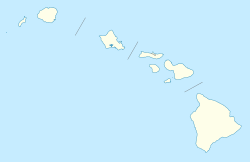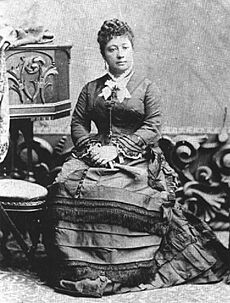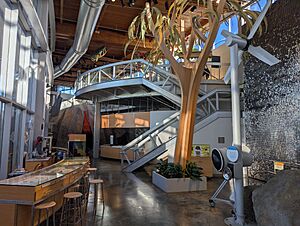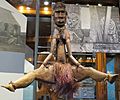Bishop Museum facts for kids
Quick facts for kids |
|
|
Bishop Museum
|
|
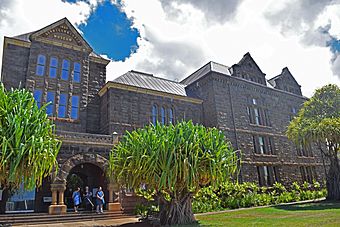
The Hawaiian Hall at the Bishop Museum contains the world's largest collection of Polynesian artifacts.
|
|
| Location | 1525 Bernice Street, Honolulu, Hawaii |
|---|---|
| Built | 1889 |
| Architect | William F. Smith |
| Architectural style | Richardsonian Romanesque |
| NRHP reference No. | 82002500 |
| Added to NRHP | July 26, 1982 |
The Bernice Pauahi Bishop Museum, also known as the Hawaiʻi State Museum of Natural and Cultural History, is a special place in Honolulu, Oʻahu, Hawaii. It's a museum of history and science that opened in 1889. It is the biggest museum in Hawaii.
The museum has the world's largest collection of cultural items from Polynesia. It also has many natural history items. There are over 24 million natural history specimens. This includes more than 13.5 million insects, making it one of the biggest insect collections in the United States. The museum also has the Richard T. Mamiya Science Adventure Center, which is a fun place for learning.
Contents
Discover the Museum's History
How the Museum Started
The Bishop Museum was built by Charles Reed Bishop (1822–1915). He was a successful businessman and helped many people. He built the museum to honor his wife, Princess Bernice Pauahi Bishop (1831–1884). She was the last royal heir of the Kamehameha family, who ruled the Kingdom of Hawaii.
Charles Reed Bishop first wanted the museum to hold his wife's family treasures. He hired William Tufts Brigham to be the first curator. Brigham later became the director and worked there until 1918.
The museum was built on the land of the Kamehameha Schools. Princess Bernice Pauahi Bishop had created these schools to help native Hawaiian children. In 1898, Charles Reed Bishop had Hawaiian Hall and Polynesian Hall built. These buildings have a special old-fashioned style called Richardsonian Romanesque. People at the time called them "the noblest buildings of Honolulu."
Today, both halls are important historical places. Hawaiian Hall has a full sperm whale skeleton. There's also a model of the whale hanging above. The walls have beautiful display cases made of koa wood. This wood is now worth more than the museum buildings themselves! You can visit the museum by taking TheBus (Honolulu) Routes A, 1, 2, 7, or 10.
The Kaimiloa Expedition: A Journey of Discovery
In 1924, a rich American named Medford Ross Kellum prepared a large ship called the Kaimiloa for a science trip. The Bishop Museum helped plan this trip. The goal was to explore many hard-to-reach places in the Pacific Ocean for five years.
A group of Hawaiian scientists joined the ship. They included a botanist (plant expert), a historian, an ethnologist (culture expert), a writer, and a doctor. The ship was like a floating laboratory. It had many bottles, boxes, and special liquids to keep insects and plants safe for the Bishop Museum.
The expedition had many important goals:
- To collect insects, plants, minerals, and old cultural items from the islands.
- To study fish and other sea life.
- To map ocean currents very carefully.
- To help the United States government correct maps of the islands.
- To try and find out where Polynesians came from, how their language developed, and how they traveled.
- To take pictures of the native people and measure parts of their bodies.
- To record their speech, songs, and chants.
- To explore the ocean floor and study how islands were formed. This helped to prove that some ideas about "lost continents" were not true.
Growing and Expanding the Museum
In 1940, the Kamehameha Schools moved to a new location. This allowed the Bishop Museum to grow. Bishop Hall, which was first used by the school, became part of the museum. Other school buildings were taken down, and new museum buildings were put up. By the late 1980s, the Bishop Museum was the biggest natural and cultural history museum in the Pacific.
In 1988, work began on the Castle Memorial Building. It opened in 1990. This building holds all the big traveling exhibits that come to the Bishop Museum from other museums around the world.
The Richard T. Mamiya Science Adventure Center opened in November 2005. This building is made for kids to learn. It has many hands-on exhibits about ocean science, volcanoes, and other cool science topics.
Museum Collections: Books, Photos, and More
The museum's library has a huge collection of books, magazines, and old newspapers. These are all about Hawaii and the Pacific. The archives also have many studies done by museum staff. They keep old writings, photographs, artwork, stories from people, and maps.
When the Bishop Museum first opened in 1891, its library was just a few shelves of books. Many Hawaiian royals, including Princess Bernice Pauahi Bishop and Queen Liliʻuokalani, gave their personal papers to the museum. The collection also includes scientific papers and family records.
The book collection has about 50,000 books. They focus on the culture and nature of Hawaii and the Pacific. This includes topics like people, music, plants, insects, and animals. The library also has many old diaries and stories from the 1700s and 1800s in Hawaii.
Special Places at the Museum
The Bishop Museum campus has several important facilities:
- The Jhamandas Watumull Planetarium is a place to learn about astronomy and space. It is the oldest planetarium in Polynesia.
- Pauahi Hall is home to the J. Linsley Gressit Center for Research in Entomology. This center has about 14 million insect specimens. It is one of the largest insect collections in the world. This is an active research center and is not open to the public.
- Pākī Hall houses the Hawaii Sports Hall of Fame. It also has a museum library and archives that are open to the public.
In 1992, the Hawaii State government created the Hawaii Biological Survey (HBS) at the Bishop Museum. The HBS studies and collects every plant and animal found in Hawaii. It has over 4 million specimens in its collections.
From 1988 to 2009, the Bishop Museum also managed the Hawaii Maritime Center in downtown Honolulu. This center was a top museum about the ocean in the Pacific. It had items related to whaling and steamships in Hawaii.
On the Big Island of Hawaiʻi, the Bishop Museum also manages the Amy B.H. Greenwell Ethnobotanical Garden. This garden specializes in plants that are native to Hawaii.
Since 1920, the Pacific Science Association (PSA) has been based at the Bishop Museum. This group works to improve science and technology in the Asia-Pacific region.
The Falls of Clyde Ship
From 1968 until 2008, the Bishop Museum owned the Falls of Clyde. This was the oldest sail-driven oil tanker ship. It was docked at the Hawaii Maritime Center. In 2007, the ship was closed to visitors because it needed repairs. The ship was tilting a lot because of a problem with its tank.
The museum spent more than $2 million to keep the ship safe between 1998 and 2008. The museum said it would sink the ship if enough money wasn't raised to take care of it forever. On September 28, 2008, a group called Friends of Falls of Clyde took ownership. They plan to fix the ship.
In October 2008, some people criticized the Bishop Museum. They said the museum had raised $600,000 to save the ship but only spent about half of that on it. They also said some of the money was spent on sandblasting that hurt the ship.
Images for kids
-
Hale pili in Hawaiian Hall, 2010
-
Sperm whale model in Hawaiian Hall, 2010
-
Hawaiian Girl with Dog, oil on canvas by John Mix Stanley, 1849
See also
 In Spanish: Bishop Museum para niños
In Spanish: Bishop Museum para niños
- Mangarevan expedition, a 1934 science trip helped by the Bishop Museum to study the nature of the farthest southeastern islands of Polynesia.
- Ray Jerome Baker, who gave a large collection of old photos and items to the museum.
- Amy B. H. Greenwell Ethnobotanical Garden
- J. T. Gulick, an early scientist who studied how living things change over time. He sold his shell collection to the Bishop Museum.


